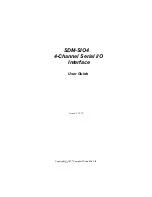
Section 8. Operation
voltages, especially those below 200 mV, such as are output from pyranometers
and thermocouples. Differential measurements also have the advantage of an
input reversal option,
RevDiff
. When
RevDiff
is
True
, two differential
measurements are made, the first with a positive polarity and the second reversed.
Subtraction of opposite polarity measurements cancels some offset voltages
associated with the measurement.
Single-ended and differential measurements without input reversal use an offset
voltage measurement with the PGIA inputs grounded. For differential
measurements without input reversal, this offset voltage measurement is
performed as part of the routine auto-calibration of the CR1000. Single-ended
measurement instructions
VoltSE()
and
TCSe()
MeasOff
parameter determines
whether the offset voltage measured is done at the beginning of measurement
instruction, or as part of self-calibration. This option provides you with the
opportunity to weigh measurement speed against measurement accuracy. When
MeasOff
=
True
, a measurement of the single-ended offset voltage is made at the
beginning of the
VoltSE()
instruction. When
MeasOff
=
False
, an offset voltage
measurement is made during self-calibration. For slowly fluctuating offset
voltages, choosing
MeasOff
=
True
for the
VoltSE()
instruction results in better
offset voltage performance.
Ratiometric measurements use an excitation voltage or current to excite the sensor
during the measurement process. Reversing excitation polarity also reduces offset
voltage error. Setting the
RevEx
parameter to
True
programs the measurement
for excitation reversal. Excitation reversal results in a polarity change of the
measured voltage so that two measurements with opposite polarity can be
subtracted and divided by 2 for offset reduction similar to input reversal for
differential measurements. Ratiometric differential measurement instructions
allow both
RevDiff
and
RevEx
to be set
True
. This results in four measurement
sequences:
•
positive excitation polarity with positive differential input polarity
•
negative excitation polarity with positive differential input polarity
•
positive excitation polarity with negative differential input polarity
•
positive excitation polarity then negative excitation differential input polarity
For ratiometric single-ended measurements, such as a
BrHalf()
, setting
RevEx
=
True
results in two measurements of opposite excitation polarity that are
subtracted and divided by 2 for offset voltage reduction. For
RevEx
=
False
for
ratiometric single-ended measurements, an offset-voltage measurement is made
during the self-calibration.
When analog voltage signals are measured in series by a single measurement
instruction, such as occurs when
VoltSE()
is programmed with
Reps
=
2
or more,
measurements on subsequent terminals may be affected by an offset, the
magnitude of which is a function of the voltage from the previous measurement.
While this offset is usually small and negligible when measuring large signals,
significant error, or
NAN
, can occur when measuring very small signals. This
effect is caused by dielectric absorption of the integrator capacitor and cannot be
overcome by circuit design. Remedies include the following:
•
Program longer settling times
•
Use an individual instruction for each input terminal, the effect of which is to
reset the integrator circuit prior to integration.
•
Avoid preceding a very small voltage input with a very large voltage input in
324
Summary of Contents for CR1000
Page 2: ......
Page 4: ......
Page 6: ......
Page 32: ......
Page 36: ......
Page 38: ......
Page 40: ......
Page 60: ...Section 4 System Quickstart Figure 16 PC200W View Line Graph 60 ...
Page 96: ......
Page 98: ...98 ...
Page 302: ......
Page 453: ...Section 8 Operation Figure 115 Using the Keyboard Display 453 ...
Page 456: ...Section 8 Operation Figure 118 Real Time Custom 456 ...
Page 457: ...Section 8 Operation 8 8 1 3 Final Memory Tables Figure 119 Final Memory Tables 457 ...
Page 458: ...Section 8 Operation 8 8 2 Run Stop Program Figure 120 Run Stop Program 458 ...
Page 460: ...Section 8 Operation Figure 122 File Edit 460 ...
Page 461: ...Section 8 Operation 8 8 4 PCCard Memory Card Display Figure 123 PCCard CF Card Display 461 ...
Page 478: ......
Page 506: ......
Page 536: ......
Page 636: ......
Page 642: ......
Page 644: ......
Page 676: ......
Page 677: ......
















































